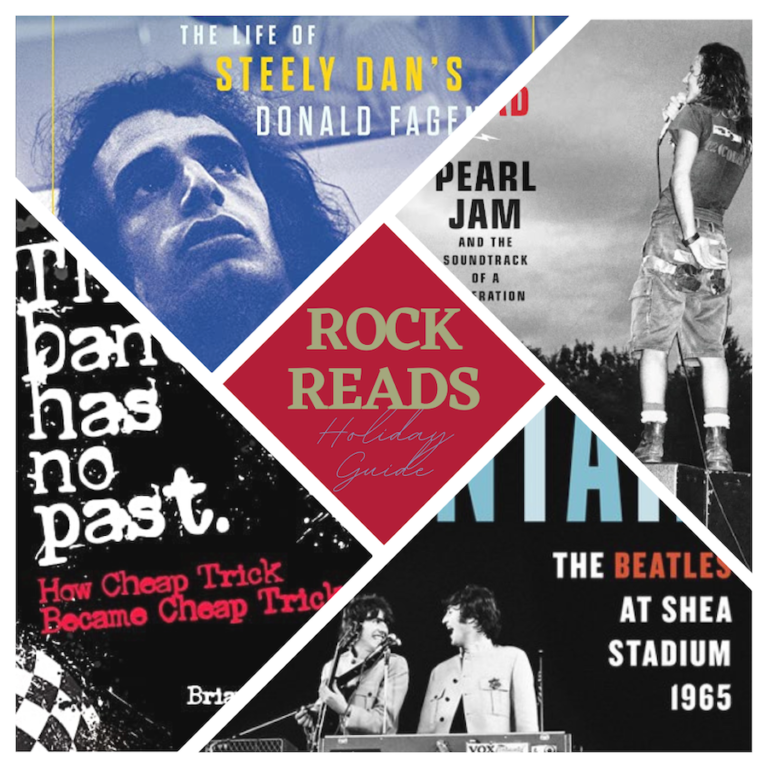Looking for a celebration of music in words to stuff the stockings of the rock fan in your life?
Long Road: Pearl Jam and the Soundtrack of a Generation by Stephen Hyden (2022)
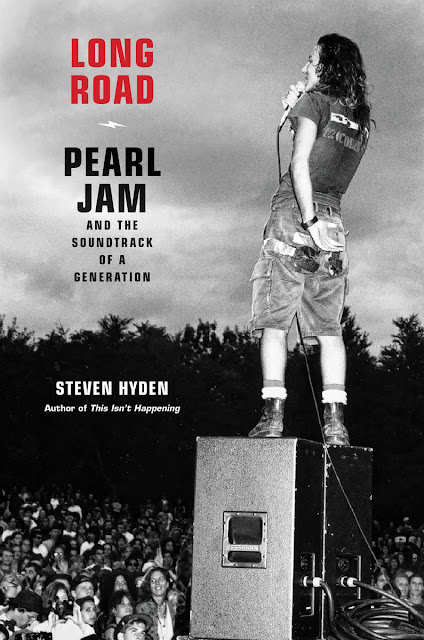
There are love letters to a band and to a musical movement and then there is Steven Hyden’s Long Road: Pearl Jam and the Soundtrack of a Generation, one of the most entertaining summations of what a rock band can do to one’s soul whether we like to admit it or not. Hyden is a music journalist and author I have gotten to know from a distance since he kindly referenced my Accidentally Like a Martyr – The Tortured Art of Warren Zevon a few years back. Previously commenting poignantly with some humor in compendiums on the music of his times, Your Favorite Band is Killing Me (2016) and Twilight of the Gods (2018), and an in-depth analysis of Radio Head’s Kid A in This Isn’t Happening (2020), this time Hyden is fully immersed in his subject.
Setting the arc and journey of Pearl Jam into seminal eras, which begins for Hyden at a June 1995 Red Rocks concert wherein the band rediscovers and reinvents itself, the book helps fans to understand how the inner workings of this collection of musicians have endured beyond the grunge movement. (The only one that has?) This includes the infamous battle with Ticketmaster that, in Hyden’s estimation, both underlined the integrity of the band while simultaneously derailing its ascent. For this reviewer, who had more or less left Pearl Jam’s evolution somewhere along 1998’s Yield, Long Run, made it fun to discover gems from their later works while marveling at the band’s survival instincts to navigate several personal and professional travails most fans never see.
Hyden also uses a similar ‘songs as guideposts’ framework that I used in Accidentally to focus on where the band was in its steady – if not enigmatic – sonic pilgrimage, ending prophetically on “Yellow Leadbetter,” a reliable concert closer that is perhaps its fans most beloved song. In the final chapter, wherein he muses on the emotional connection a band’s run has on our fraying thread of memories, Hyden writes, “You see a band you have loved most of your life, and if they can still move you, then time manages to stand still. But only for a while. And only if they can still do this. Because one day, they won’t.”
Nightfly: The Life of Steely Dan‘s Donald Fagan by Peter Jones (2022)

Obsessive perfectionist, anti-social curmudgeon, musical pioneer – Donald Fagan, and to a great extent his musical partner, Walter Becker, co-founders of the inscrutable jazz/rock/pop combo Steely Dan, are all of those and more. Peter Jones’ Nighfly lifts the veil on the mysteries of the band that hid in plain sight while they challenged music industry norms and managed to simultaneously boast huge hits during the 1970s. The method, the madness, and the fallout of their partnership/kinship are duly covered and brought to light in what Jones describes as a “critical biography,” but reads as sonic psychoanalysis.
A painfully private subject is both a blessing and curse for biographers. Readers want to know it all, since so little has been offered by the subject – I am reminded of the recent ESPN series on legendary New York Yankees player Derek Jeter – but perhaps it is their public output that speaks volumes; hence “hiding in plain sight.” Fagan revealed so much of his psyche in his songs, anguish, lust, sarcasm, and a general hopeless for humanity. The humor of his lyrics, the adoration of trad jazz and early rhythm and blues, comes through loud and clear. To that end, Jones succeeds in letting us into that world, providing more than a sneak-peak into Fagan’s past, his dreams, his fears, and his seemingly unwavering worldview, along with the incredible dedication to making music the way he and Becker heard it in their heads. Their silent, mystical bond is what intrigued me the most, and Nightfly gets to its core as well as any account I have read thus far.
Nightfly is indeed a “critical biography” in that hits all elements of an underrated commentator of his times that oddly never saw past the keys on his piano.
The Band Has No Past – How Cheap Trick Became Cheap Trick by Brian J. Kramp (2022)
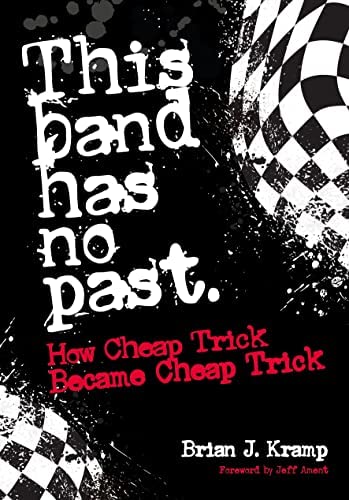
In May of 2017, I met Robin Zander and Rick Nielsen of Cheap Trick at a Rock Nation event in NYC. In a crowded hallway awaiting the press, they bitched to me about no one having attempted to capture the incredible origins of their band. And although neither of them contributed directly to this incredibly comprehensive oral biography, I hope they see it as I do: an endearing capsule of a beloved American rock band.
Brian Kamp has compiled a nearly day-to-day, gig-to-gig overview of Cheap Trick’s rise to rock legend that all fans of any band would want to consume. From the mid-to-late 1960s up through the third-generation rock and roll era, and smack through punk, funk, and power-pop, Cheap Trick remained true to its mission to create off-kilter songs that unleash a bombastic, live, and visual assault from Sheboygan to a noisy hamlet near you. The Rockford, Illinois quartet overcame every music biz cliché in the book, and in this book in particular, more than any in recent memory.
This Band Has No Past – a clever title based on the smarmy quasi-bio Cheap Trick included in its initial album release – lets the voices behind the scenes and beyond the band tell the tale, from artists who passed through their many lineups over the years to bands that shared bills with them, and, of course, managers, booking agents, groupies, roadies, toadies, and fans galore. This is a true coming of ‘stage’ story, one filled with incredible anecdotes and the type of rock music lore that keeps the pages turning.
Top of the Mountain: The Beatles at Shea Stadium 1965 by Laurie Jacobson (2022)
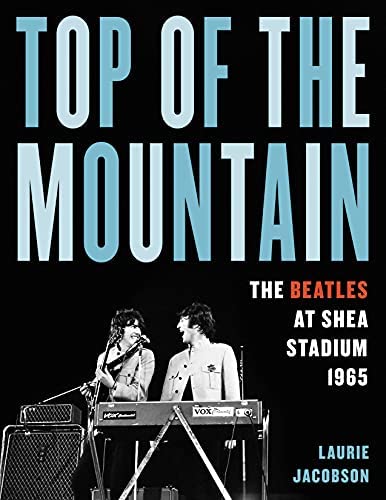
Full disclosure: I met the author at the annual Fest for Beatles Fans in Chicago this past summer and found her delightful, funny, and wholly passionate about her subject. Laurie Jacobsen, who boasts a long bibliography of writing about her time in and around Hollywood over many years, has laser-focused her unique comprehension of the entertainment business with a genuine love and fascination with the Beatles. All of this comes through on every page of her wonderful new book, Top of the Mountain: The Beatles at Shea Stadium 1965.
We had a running joke between us – I wrote a book about one Beatles song, Take a Sad Song – The Emotional Currency of “Hey Jude,” and she wrote one about one concert. What Jacobsen has done is provide the reader with a scrapbook of Beatlemania at its absolute height (hence, the title taken from John Lennon’s observation of the event) and a blow-by-blow history of its origins, planning, execution, and legacy.
Those who were there will appreciate her attention to the details of the times – memorabilia, ads, ticket stubs, contracts – and those who were not can be taken back in time to a magical first foray into the massive business of rock and roll, including tours, sponsors, management, marketing, and hyperbole, also providing a glimpse of the singular phenomenon that was the Beatles.
However, there is more to Top of the Mountain than mere visual memories. Jacobsen fills the pages with anecdotes from those who packed its capacity audience, like Meryl Streep, promising to wash dishes for four years to procure tickets from her parents, Whoopi Goldberg, who was surprised with tickets from her mom on the way to show, the Supremes’ Mary Wilson, as well as E Street’s Steven Van Zandt and more.
Mostly, Jacobson delivers a proper tribute to longtime promoter, Sid Bernstein, the man who brought the Beatles to America on instinct, grit, determination, and lots of finagling. Before anyone cared about them, Bernstein had the foresight to envision the Beatles as America’s sweethearts while also portending a world in which the rock event superseded the mere one-off shows prevalent in 1965 to another one that would launch a period of massive youth events (Monterey Pop, Woodstock, Live Aid, etc) and stadium sellouts for the rest of the genre’s long history.
The Number Ones: Twenty Chart-Topping Hits That Reveal the History of Pop Music by Tom Breihan (2022)
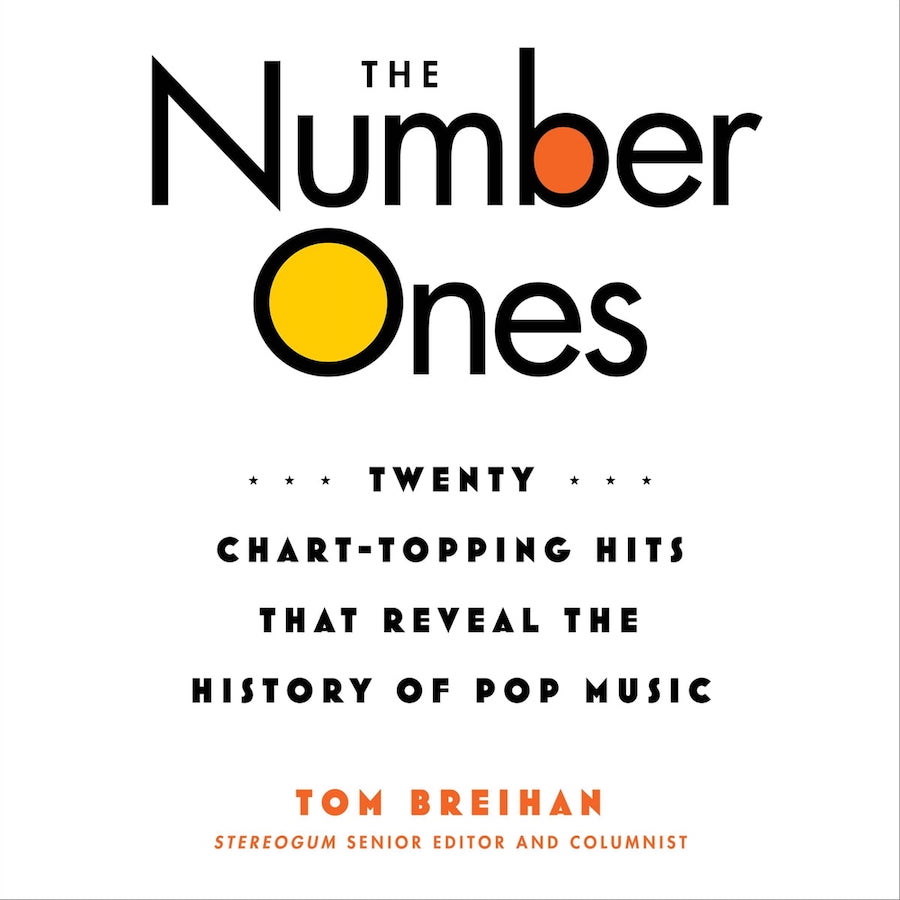
Tom Breihan is a nut. This is precisely why I love him. Fellow music journalist and columnist for Stereogum began penning a daily – and eventually, due to agonizing combination of madness and exhaustion, bi-daily – review of every No. 1 hit on the Billboard charts since its inception in 1958 to the present. By the time of this writing Breihan is in the early aughts, and in the interim had a fantastic idea to turn this passion into a book by adding more in-depth historical perspectives on the most seminal of popular songs to our musical culture at large. The Number Ones: Twenty Chart-Topping Hits That Reveal the History of Pop Music is a tour de force of Breihan at his most nerdy, intricate, and enjoyable.
With these things, there will always be complaints and counterarguments… which makes it all the more fun. And as I was ready pounce on what may be a song added or missed in his 20 hits, I was pleasantly surprised that I agreed with them all. These include the primacy of the dance craze spark of Chubby Checker’s “The Twist,” the female teenage coming out party of songwriting team Carole King and Gerry Goffin’s masterpiece, “Will You Still Love Me Tomorrow,” the genre obliterating “I Want to Hold Your Hand,” and “Billie Jean” by the two dominate chart figures of the 20th century, the Beatles and Michael Jackson, and a grand nod to Mariah Carey, duly covered here as her spate of chart toppers (19) which only bows to the Beatles (20) thus far.
No one parses the stories or puts the popular songs that have defined generations into perspective better than Breihan, who has delivered on the promise of his crazy column idea.
Sam Phillips: The Man Who Invented Rock ‘N’ Roll by Peter Guralnick (2015)
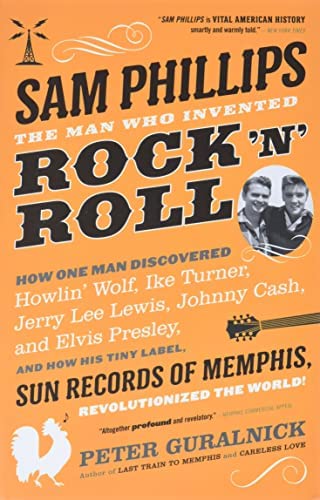
This is the finest biography I have ever read on anyone, and Sam Phillips, its subject, may be the most interesting figure that could fill a volume of this magnitude. This includes such luminaries as founding father, John Adams, the madman Nazi propagandist Joseph Goebbels, the man who saved America’s pastime, Babe Ruth, and most of the things I’ve read about Jim Morrison. The layers and tragedies and triumphs and immense legacy of Sam Phillips on the evolution and eventual global dominance and influence of American music (and its ensuing latter 20th century culture boom) are all covered in page-turning ecstasy in Peter Guralnick’s The Man Who Invented Rock and Roll.
Phillips’ story is that of the American maverick who overcomes childhood trauma, mental illness, financial hardships, and personal foibles to conquer an industry filled with kooks and vipers. We know about his discovering and recording of Elvis Presley’s incredible early catalog (replete with his inventing the reverb-soaked slap-back sound that changed the sonic landscape of early rock and roll), but there is also Phillips’ enduring love and discovery of inimitable blues masters Howlin’ Wolf and B.B. King, the parade of country/rock stalwarts, Jerry Lee Lewis, Carl Perkins, Johnny Cash, and pop icon Roy Orbison. But what about his championing for the Black, poor, mostly ignored titans that provided the framework for rock and roll and recording what is arguably the world’s first rock and roll record, “Rocket 88,” or his founding of the world’s first women’s radio station (WHER), and a union of America’s independent studio owners, all of it in the Jim Crow American South?
Sam Phillips: The Man Who Invented Rock ‘N’ Roll is a masterful biography worthy of its immense subject and his enduring legacy.


